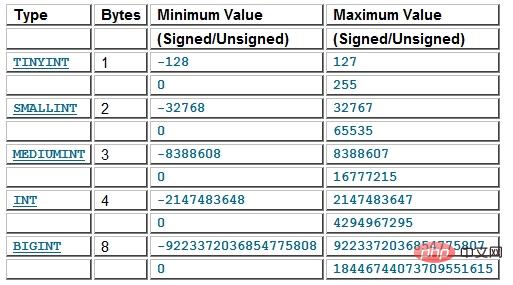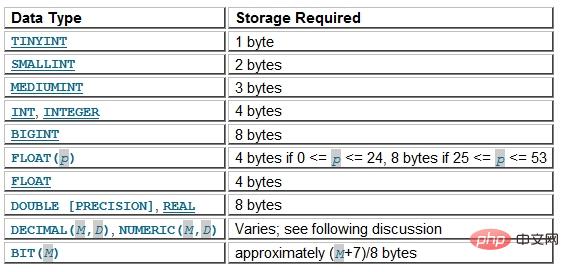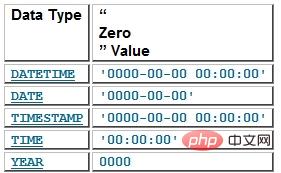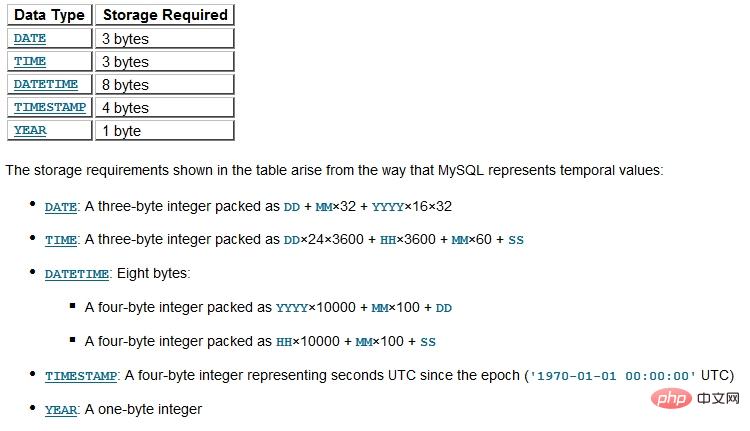What are the mysql data types?
mysql data types include: 1. Numeric type; 2. Date and time type; 3. String types are CHAR, VARCHAR, BINARY [binary data type], BLOB, TEXT [text type], ENUM [ Enumeration type] and SET [data collection].

mysql data types are:
The data types supported by MySQL are in several categories: Numeric types, date and time types and string (character) types.
Data type:


Note:
We often use num int when defining fields (10) In this way of writing unsigned, the int(10) does not mean that the field will store 10-length numbers.
int(M) represents the format of number display, and is only valid when the field attribute is set to zerofill.
eg:
Tinyint(4) -- The actual stored value is 2. If zerofill is not specified, the result of the query is 2. If zerofill is specified, then The query result is 0002, and 0 is used to fill the left side;
zerofill attribute:
If the field specifies the zerofill attribute, mysql will automatically Field plus UNSIGNED attribute.
The ZEROFILL attribute is ignored when involved in column expressions or UNION queries
Floating point:
Float(M,D): M is the number of digits in the number, including the integer part and decimal part; D is The decimal part ,[D <= M-2]; If equal, the integer part is 0, and the maximum value is 0.99
eg:
Float(2,1) -- represents one integer and one decimal, eg:1.1
- ## Float(1,2) --
Syntax error, only 1 digits How can there be 2 decimal places
## About the default value:
- The default value must be a constant light, not a function or expression. Exception: The default value of
- TIMESTAMP
can be used CURRENT_TIMESTAMP
##BLOB and TEXT Cannot set default value -
If a column does not clearly indicate the default value:
- strict mode
-
mode, an error will be reported
If the mode is not in strict mode mode, the system will confirm the use according to the type What default value
Date and time format:
The date and time type representing time value is datetime (DATATIME) , date (DATA), timestamp (TIMESTAMP), time (TIME) and year (YEAR).
 DATATIME range:
DATATIME range:  '1000-01-01 00:00:00'
'1000-01-01 00:00:00'
'9999-12-31 23 :59:59'. DATA range: '1000-01-01'
'9999-12-31' TIMESTAMP range: '1970-01-01 00:00:01'
'2038-01-19 03:14:07' TIME range :'-838:59:59'
'838:59:59'
YEAR range: year(4) --- 1901~2155; year(2) --- 00~99
TIMESTAMP: The timestamp column is displayed in the same format as the DATETIME column. In other words, the display width is fixed to 19 characters and the format is 'YYYY-MM-DD HH:MM:SS'.
The TIMESTAMP data type provides automatic initialization and update. But there can only be one column with default value and update specified as CURRENT_TIMESTAMP
1. Automatic initialization and automatic update eg: ts TIMESTAMP DEFAULT CURRENT_TIMESTAMP ON UPDATE CURRENT_TIMESTAMP
2. Only automatic initialization; eg: ts TIMESTAMP DEFAULT CURRENT_TIMESTAMP
3. Only automatic update; eg: ts TIMESTAMP DEFAULT 0 ON UPDATE CURRENT_TIMESTAMP
4. None; eg: ts TIMESTAMP DEFAULT 0
String type :
The string types are CHAR, VARCHAR, BINARY [binary data type], BLOB, TEXT [text type], ENUM [enumeration type] and SET [data collection].
The difference between char and varchar: the difference in storage length lies in the maximum length and whether to retain spaces;
Char will retain spaces, varchar will not retain spaces
char is 0~255; varchar is 0~65535

## ENUM: An enumeration is a string object that selects a value from a list that explicitly enumerates the allowed values for the column specification when creating the table. [When the inserted value cannot match the value of the list, the default is the maximum index value]
, ,
numbers ENUM('0','1','2')
mysql> INSERT INTO t (numbers) VALUES(2),('2'),('3');mysql> SELECT * FROM t;+---------+ | numbers | +---------+ | 1 | | 2 | | 2 | +---------+
SET: A set is an object that can have zero or more value strings, each of which must be selected from a list to allow the value specified when creating the table. [When the inserted value cannot match the value of the list, MYSQL will ignore the value that does not exist in the list]
1 CREATE TABLE myset (col SET('a', 'b', 'c', 'd'));2 3 INSERT INTO myset (col) VALUES ('a,d'), ('d,a'), ('a,d,a'), ('a,d,d'), ('d,a,d');
It can be seen from the definition of ENUM The difference from SET is whether the value is one or more of the values specified when defining. There is also a different behavior when the inserted value does not exist in the list.
More related free learning recommendations: mysql tutorial(Video)
The above is the detailed content of What are the mysql data types?. For more information, please follow other related articles on the PHP Chinese website!

Hot AI Tools

Undresser.AI Undress
AI-powered app for creating realistic nude photos

AI Clothes Remover
Online AI tool for removing clothes from photos.

Undress AI Tool
Undress images for free

Clothoff.io
AI clothes remover

Video Face Swap
Swap faces in any video effortlessly with our completely free AI face swap tool!

Hot Article

Hot Tools

Notepad++7.3.1
Easy-to-use and free code editor

SublimeText3 Chinese version
Chinese version, very easy to use

Zend Studio 13.0.1
Powerful PHP integrated development environment

Dreamweaver CS6
Visual web development tools

SublimeText3 Mac version
God-level code editing software (SublimeText3)

Hot Topics
 1672
1672
 14
14
 1428
1428
 52
52
 1332
1332
 25
25
 1277
1277
 29
29
 1257
1257
 24
24
 MySQL and phpMyAdmin: Core Features and Functions
Apr 22, 2025 am 12:12 AM
MySQL and phpMyAdmin: Core Features and Functions
Apr 22, 2025 am 12:12 AM
MySQL and phpMyAdmin are powerful database management tools. 1) MySQL is used to create databases and tables, and to execute DML and SQL queries. 2) phpMyAdmin provides an intuitive interface for database management, table structure management, data operations and user permission management.
 MySQL vs. Other Programming Languages: A Comparison
Apr 19, 2025 am 12:22 AM
MySQL vs. Other Programming Languages: A Comparison
Apr 19, 2025 am 12:22 AM
Compared with other programming languages, MySQL is mainly used to store and manage data, while other languages such as Python, Java, and C are used for logical processing and application development. MySQL is known for its high performance, scalability and cross-platform support, suitable for data management needs, while other languages have advantages in their respective fields such as data analytics, enterprise applications, and system programming.
 Explain the purpose of foreign keys in MySQL.
Apr 25, 2025 am 12:17 AM
Explain the purpose of foreign keys in MySQL.
Apr 25, 2025 am 12:17 AM
In MySQL, the function of foreign keys is to establish the relationship between tables and ensure the consistency and integrity of the data. Foreign keys maintain the effectiveness of data through reference integrity checks and cascading operations. Pay attention to performance optimization and avoid common errors when using them.
 Compare and contrast MySQL and MariaDB.
Apr 26, 2025 am 12:08 AM
Compare and contrast MySQL and MariaDB.
Apr 26, 2025 am 12:08 AM
The main difference between MySQL and MariaDB is performance, functionality and license: 1. MySQL is developed by Oracle, and MariaDB is its fork. 2. MariaDB may perform better in high load environments. 3.MariaDB provides more storage engines and functions. 4.MySQL adopts a dual license, and MariaDB is completely open source. The existing infrastructure, performance requirements, functional requirements and license costs should be taken into account when choosing.
 SQL vs. MySQL: Clarifying the Relationship Between the Two
Apr 24, 2025 am 12:02 AM
SQL vs. MySQL: Clarifying the Relationship Between the Two
Apr 24, 2025 am 12:02 AM
SQL is a standard language for managing relational databases, while MySQL is a database management system that uses SQL. SQL defines ways to interact with a database, including CRUD operations, while MySQL implements the SQL standard and provides additional features such as stored procedures and triggers.
 MySQL: The Database, phpMyAdmin: The Management Interface
Apr 29, 2025 am 12:44 AM
MySQL: The Database, phpMyAdmin: The Management Interface
Apr 29, 2025 am 12:44 AM
MySQL and phpMyAdmin can be effectively managed through the following steps: 1. Create and delete database: Just click in phpMyAdmin to complete. 2. Manage tables: You can create tables, modify structures, and add indexes. 3. Data operation: Supports inserting, updating, deleting data and executing SQL queries. 4. Import and export data: Supports SQL, CSV, XML and other formats. 5. Optimization and monitoring: Use the OPTIMIZETABLE command to optimize tables and use query analyzers and monitoring tools to solve performance problems.
 How to safely store JavaScript objects containing functions and regular expressions to a database and restore?
Apr 19, 2025 pm 11:09 PM
How to safely store JavaScript objects containing functions and regular expressions to a database and restore?
Apr 19, 2025 pm 11:09 PM
Safely handle functions and regular expressions in JSON In front-end development, JavaScript is often required...
 Steps to add and delete fields to MySQL tables
Apr 29, 2025 pm 04:15 PM
Steps to add and delete fields to MySQL tables
Apr 29, 2025 pm 04:15 PM
In MySQL, add fields using ALTERTABLEtable_nameADDCOLUMNnew_columnVARCHAR(255)AFTERexisting_column, delete fields using ALTERTABLEtable_nameDROPCOLUMNcolumn_to_drop. When adding fields, you need to specify a location to optimize query performance and data structure; before deleting fields, you need to confirm that the operation is irreversible; modifying table structure using online DDL, backup data, test environment, and low-load time periods is performance optimization and best practice.




